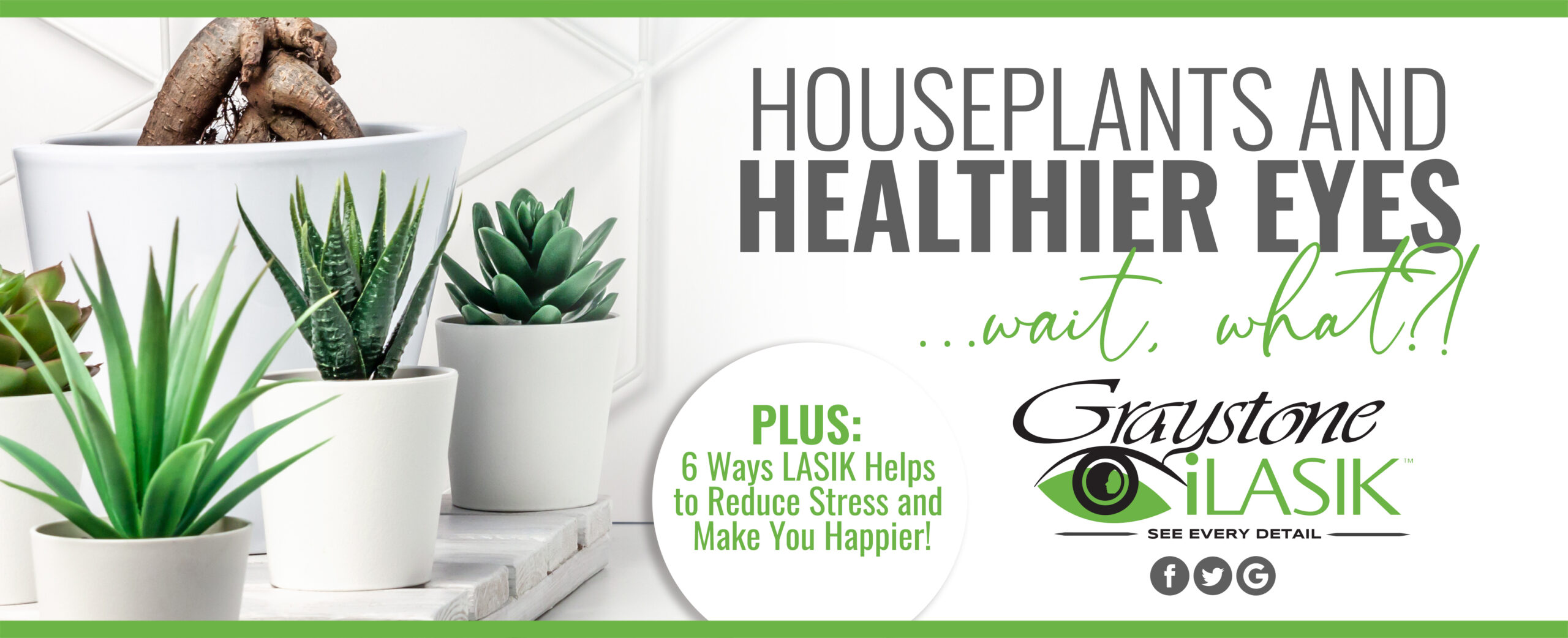If you’re an avid plant lover, you already know that plants are easy on the eyes (pun intended). But did you also know they can help to create a more friendly environment for your eyes? According to the EPA, Americans spend approximately 90 percent of their time indoors, where the concentrations of some pollutants are often 2 to 5 times higher than they typically are outdoors. (1)
So, you’re probably wondering “How does this affect my eyes”? Particles from pollutants such as carbon monoxide, cleaning supplies, paints, carpets, dust mites, pet dander, mold, and typically drier indoor air can cause eye irritation and chronic dryness (add contacts into the mix, and your life can be a mess…).
[Cue Houseplants] Houseplants absorb carbon dioxide and other indoor pollutants, release oxygen and increase moisture levels in the air (did you know that of all the water absorbed by plants, less than 5% remains in the plant for growth?). In fact, studies show that introducing the right kind of greenery in your living space can be a low-cost, environment-friendly solution for improving indoor air quality by reducing harmful airborne chemicals and allergens significantly over a 48-hour period. (Still curious? …check out phytoremediation and transpiration).
Here Are Several Common Houseplants and How They Work Their Magic*:
Aloe Vera. These plants work at night to absorb carbon dioxide and release oxygen as you sleep. The gel-like sap from aloe vera is also a great aid in helping to heal cuts and burns. (Not pet friendly.)
Chrysanthemum. On NASA’s list of top air-purifying plants, mums remove ammonia, benzene and formaldehyde from indoor air. (Not child/pet friendly.)
Bamboo. Besides adding a tropical feel to your living space, bamboo plants are excellent at reducing airborne formaldehyde which is often released by new flooring, furniture, fabrics and paints.
Boston Fern. Not just beautiful, ferns are a super-efficient air purifier that is especially good at removing formaldehyde, as well as benzene and xylene.
English Ivy. This versatile houseplant works to purify airborne mold particles that can trigger allergies. (Not pet friendly.)
Golden Pothos. Attractive and easy to grow, this is easily one of the most common houseplants. It’s attractive and easy to grow, and is considered a great air-purifying houseplant. (Not child/pet friendly.)
Peace Lily. A master of air pollutant removal, peace lilies absorb ammonia, benzene, xylene, formaldehyde and trichloroethylene. (Not pet friendly.)
Snake Plant. Another plant that works as you sleep to convert carbon dioxide into oxygen. They also remove toxins from the air including trichloroethylene, formaldehyde, toluene, benzene and xylene. (Not pet friendly.)
Spider Plant. One of the easiest to care for, this plant removes formaldehyde from the air, targets carbon monoxide, and is one of the best plants you can buy for increasing indoor humidity. (Spider Plants are mildly hallucinogens to cats. Who knew?)
Besides helping your eyes, studies have shown that having houseplants can also help to reduce stress, boost creativity, increase productivity and attention span… and overall, just make you feel happier.
*It’s important to know which plants are toxic if you have children or pets in the home (www.aspca.org). If you have asthma or allergies, be alert to species that aggravate your symptoms. If you suffer from dry eye, a simple conversation with your eye doctor can help you explore treatment options so that you can find relief from the discomfort of these symptoms.
(1) https://www.epa.gov/report-environment/indoor-air-quality
—
Here are 6 Ways LASIK Also Helps to Reduce Stress and Make You Happier…
LASIK changes lives, opening up a whole new world you’ve never seen before…
Better Vision. According to the latest research, LASIK results in 20/40 vision or better for 99% of patients, and 20/20 or better for 90% of patients. Patient satisfaction rates are consistently at 96%.
Recreational Improvements. You can play sports without the worry of breaking your glasses, or fear of losing a contact… and, you can actually see while you swim!
Health Benefits. Touching your eyes to insert, remove or constantly adjust contacts can cause irritation, as well as introduce allergens and infections. After LASIK, there’s no need to touch your eyes multiple times a day!
Lighter Travel. Not only do glasses and contacts take up space in your bags… forgetting them could affect your entire trip.
Big Savings. LASIK has a one-time cost that will rid you of all eyewear expenses (and associated appointment costs) – and let’s not even mention prescription sunglasses.
A Confidence Boost. No need to feel self-conscious because of your large or thick frames, or constantly having to push your glasses up when they slide down your nose. Goodbye Glasses… Hello Freedom!
Are you ready to say goodbye to those glasses and/or contacts yet? Have questions about LASIK or been told that you’re not a candidate (you did know there are other options available, right)? Contact us today at (828) 304-6611 for a FREE consultation to see which vision correction option is the best solution for you.
R.E. “Trey” Oursler, III, MD | Refractive Surgeon at Graystone Eye
Dr. Oursler obtained his bachelor’s degree from Emory University in Atlanta, GA, and attended Wake Forest University Medical School. He completed his ophthalmology residency at Wills Eye Hospital in Philadelphia, PA, and a LASIK fellowship at the Barnet-Dulaney Eye Center in Phoenix, AZ. He has performed over 50,000 refractive procedures, including iLASIK, Surface Laser Correction, and Refractive Lens Exchange; and is consistently listed among the Top 50 Visx® LASIK surgeons in the country.

